This isn’t your traditional fried rice.
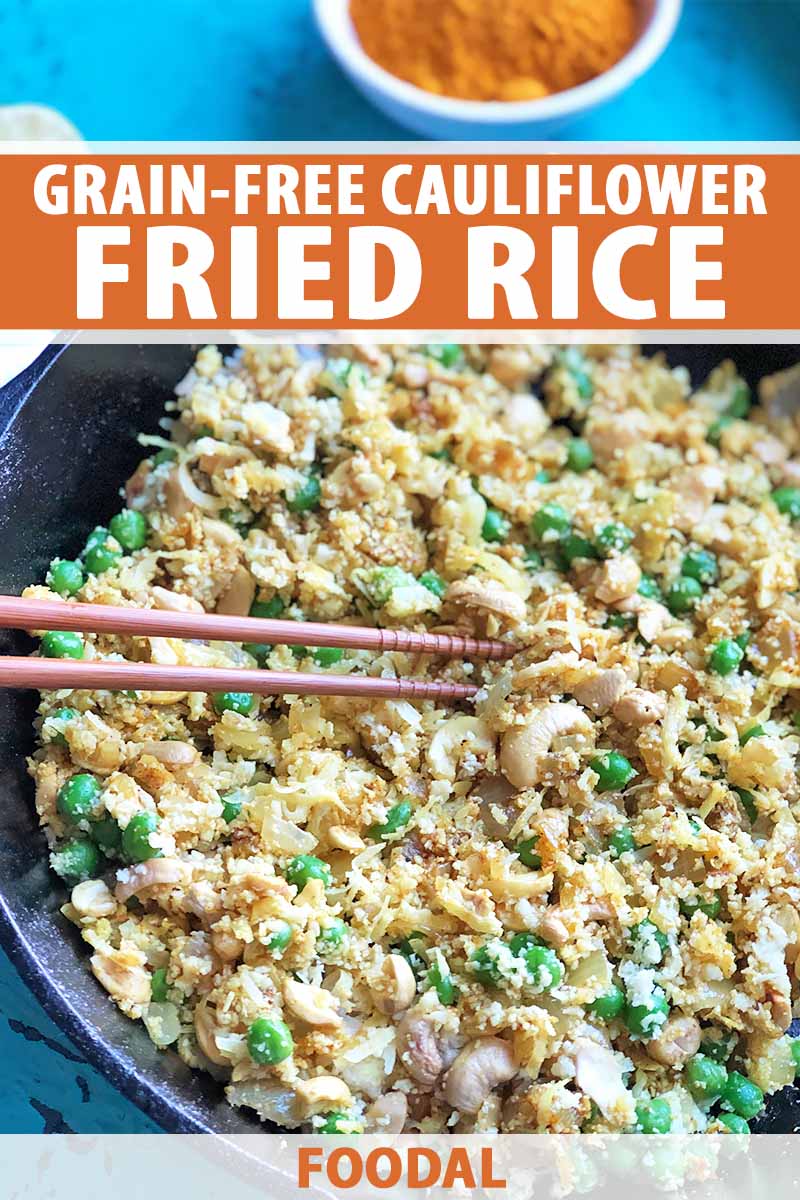
Usually when I think of fried rice I think of, well, white rice. With peas, carrots, sometimes some meat, and lots of soy sauce.
As much as I love that umami flavor, I’m an even bigger fan of the warm, complex flavors in this Indian-spiced low-carb version.
Now, I don’t know about you, but for the longest time I avoided making Indian recipes as I was intimidated by the seemingly complicated combinations of spices.
But once I finally took the plunge and added a few staples to my spice rack, a new world of recipes and flavors was opened to me. So, if you’re worried about investing in a few new spices, I want to encourage you to just go ahead and do it – we’ll make sure to keep bringing you more recipes to use them in.
Speaking of spices, let’s talk about what you’ll need for this recipe.
First up is turmeric. Used for thousands of years in Ayurvedic medicine, turmeric has become super trendy more recently thanks to its bright yellow color and medicinal benefits. It can be used as an alternative to artificial dyes as well as a tasty flavoring.
Thanks to a compound called curcumin, turmeric has been shown to help reduce inflammation, ease joint pain, promote heart health, reduce the risk of cancer, and reduce symptoms of anxiety and depression.
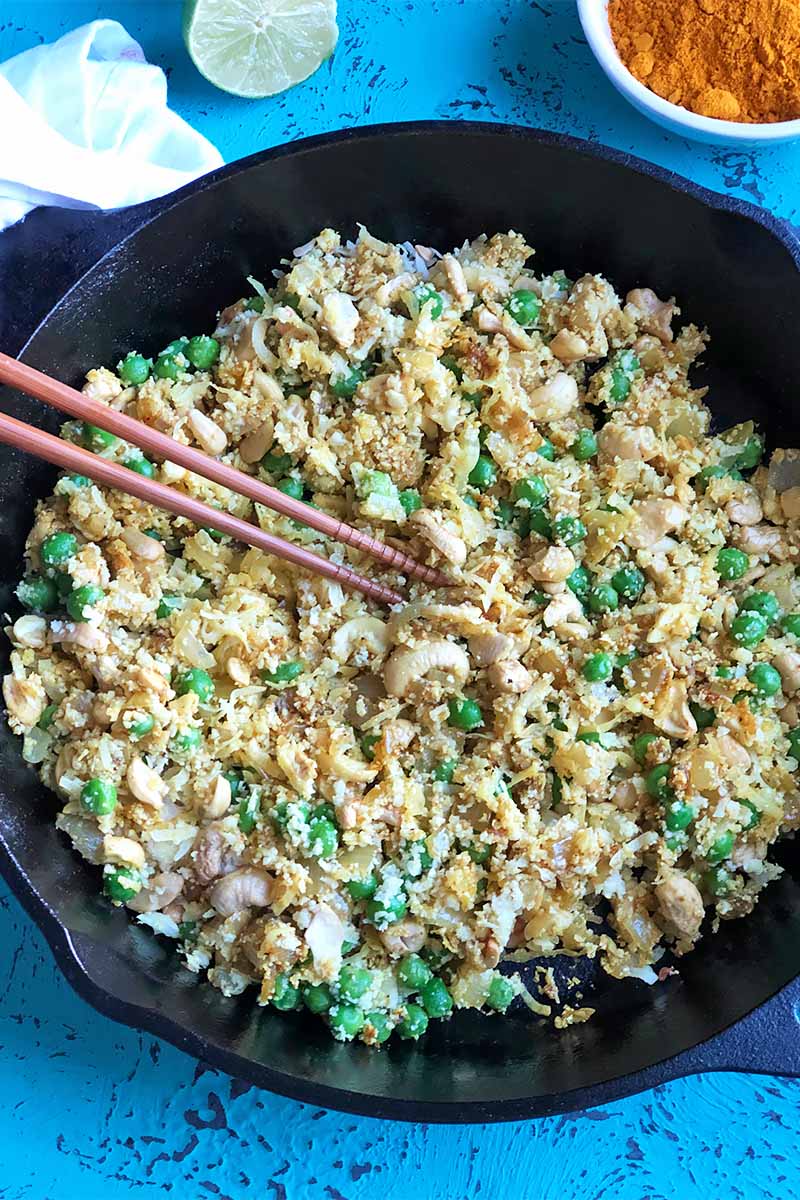
You’ll notice that recipes calling for turmeric often also include black pepper. A compound called piperine in black pepper has been found to significantly enhance the absorption of curcumin in turmeric.
Ginger is a warming spice that has been used through the ages in Ayurvedic medicine to promote healthy digestion, as well as by herbalists and alternative medicine practitioners for alleviating various ailments right through to today. It’s known for its antiinflammatory properties, and chewing on ginger can even help to combat nausea.
This recipe uses the dried, powdered version, but fresh ginger – often in combination with garlic – is a staple in many Indian dishes.
Finally, this recipe calls for a spice blend known as garam masala. Common in Indian cooking, every family, restaurant, and region has their own way of making it. The quantity of certain spices and the amount of heat from cayenne pepper in a given combination can vary depending on the source.
For a stronger flavor, the whole spices used in garam masala are usually toasted before being ground to a powder and combined.
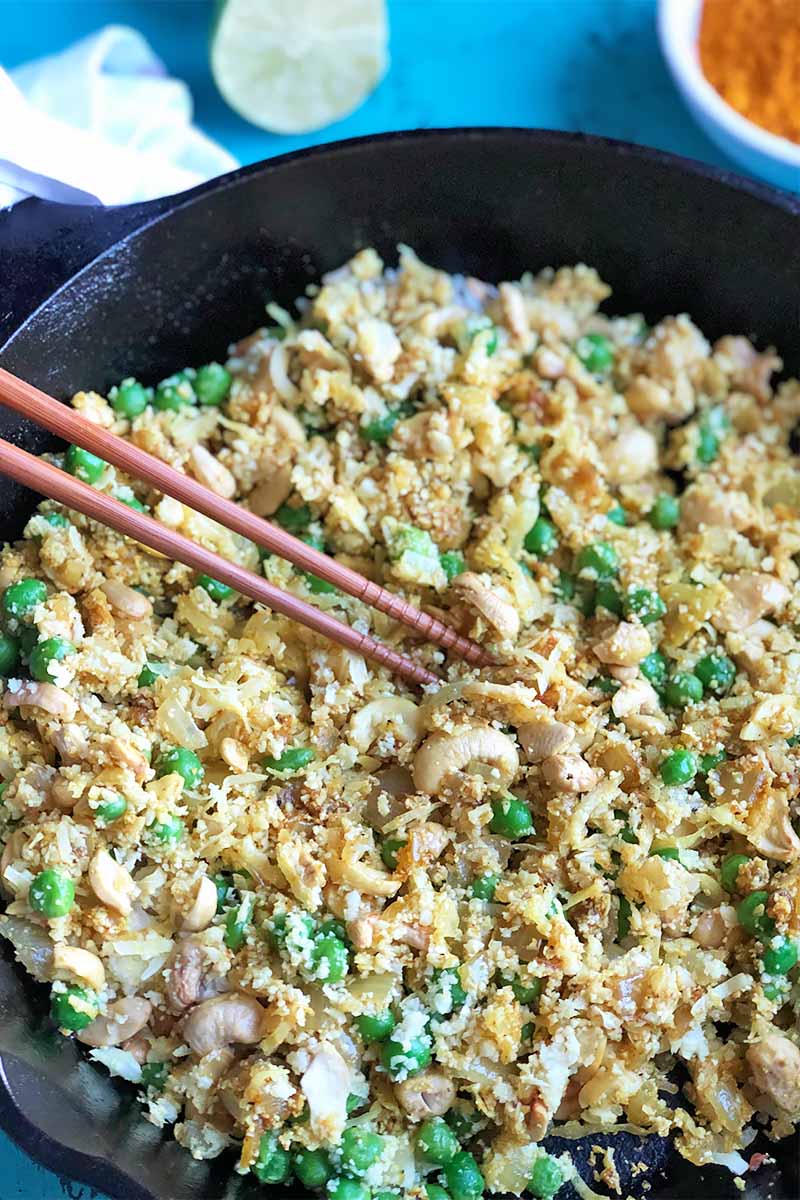
Beyond these spices, there’s a good chance you already have many of the ingredients needed to make for this cauliflower fried “rice” at home: cashews, peas, coconut, salt, lime juice, and of course, cauliflower.
To cut back on carbs and add extra nutrition, we’re subbing out rice for riced cauliflower in this dish. While you can buy pre-riced cauliflower in the frozen foods aisle, it’s also easy to make with a food processor at home. Don’t worry, we’ll walk you through how to do this below!
If you’re more interested in the flavor and potential health benefits of the spices as opposed to the the low-carb aspect of this recipe, you can sub in cooked brown or white rice if you prefer. Jasmine rice in particular would add some nice floral notes, but I do prefer brown rice, which has a more robust nutritional profile than polished white rice.
While this recipe can stand on its own as a vegetarian main, crumbled tofu can be added for an extra dose of protein. Or, for a non-vegetarian version, cooked ground pork, diced chicken, or shrimp would all work well too.
So, grab those spices and get to sauteing! In just 25 minutes you’ll have a flavor-filled meal to warm you from the inside out.
Print
Grain-Free Indian-Spiced Cauliflower Fried “Rice” with Cashews and Coconut
- Total Time: 25 minutes
- Yield: 2 servings as an entree, 4 as a side dish 1x
Description
Filled with warm Indian spices, this grain-free cauliflower fried “rice” is a healthy way to get dinner on the table in less than 30 minutes.
Ingredients
- 1/2 cup raw cashews
- 6 tablespoons unsweetened coconut flakes
- 2 tablespoons coconut oil
- 3/4 cup diced yellow onion
- 1/4 teaspoon ground black pepper
- 1/2 teaspoon ground ginger
- 1/2 teaspoon garam masala
- 1 teaspoon ground turmeric
- 1 teaspoon salt
- 1 cup riced cauliflower
- 2/3 cup frozen green peas
- Juice of 1/2 lime
Instructions
- Place raw cashews in a large skillet over medium-low heat. Cook until lightly toasted, about 5 minutes, stirring occasionally. Remove from skillet and set aside.
- Return the pan to medium-low heat. Add coconut flakes and toast for 1-2 minutes, or until edges are just lightly browned, stirring occasionally. Remove from skillet and set aside.
- Place coconut oil in skillet and increase heat to medium. Once oil has melted, add onion and cook for 3 minutes or until translucent, stirring frequently.
- Add ground black pepper, ginger, garam masala, turmeric, and salt. Stir to combine. Cook for 1 minute or until fragrant, stirring occasionally.
- Stir in riced cauliflower, frozen peas, cashews, and coconut. Cook until peas and cauliflower are heated through.
- Remove skillet from heat and stir in lime juice. Serve immediately.
- Prep Time: 10 minutes
- Cook Time: 15 minutes
- Category: Side Dish
- Method: Stovetop
- Cuisine: Vegan
Keywords: cauliflower, fried rice, Indian cuisine, garam masala, coconut flakes, peas
Cooking By the Numbers…
Step 1 – Rice Cauliflower, Dice Onion, Juice Lime, and Measure Ingredients

To make your own cauliflower rice, you’ll need about half of a large head or most of a medium-sized one.
Start by rinsing the cauliflower well and cutting it in half. Remove the stem. Break one of the large halves into florets (or more if starting with a smaller vegetable), and wrap the other half in plastic wrap to store and use in another recipe.
Place the florets in a food processor and pulse until the cauliflower is chopped uniformly and has a similar texture to short-grain rice. Scrape down the sides of the food processor with a spatula as needed. Measure out 1 cup of cauliflower rice and set it aside.
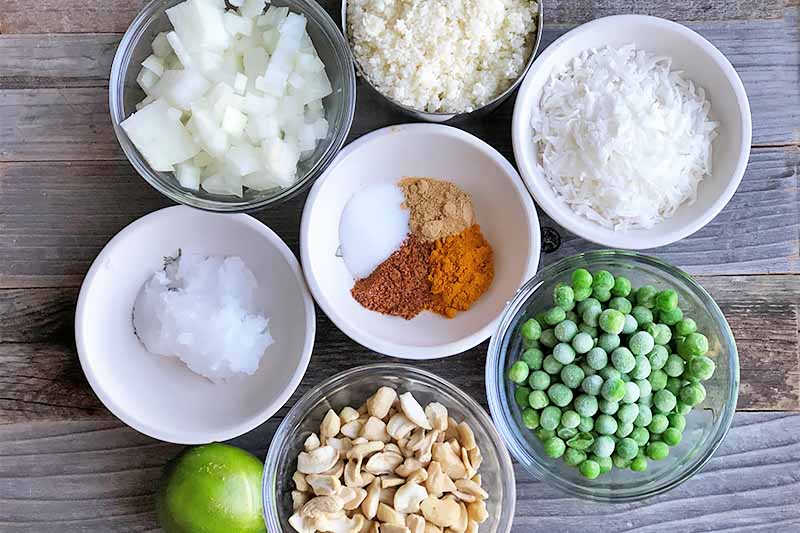
If you have any excess, you can freeze and save it for use later. You can also feel free to buy pre-riced cauliflower in the frozen foods section of the grocery store.
Next, it’s time to dice the onion. Not a fan of this task? Check out our tips to say goodbye to those tears!
Juice half of a lime, to yield about one tablespoon of juice.
Measure out all of the remaining ingredients, so they will be ready to go when you need them.
Step 2 – Toast Cashews and Coconut
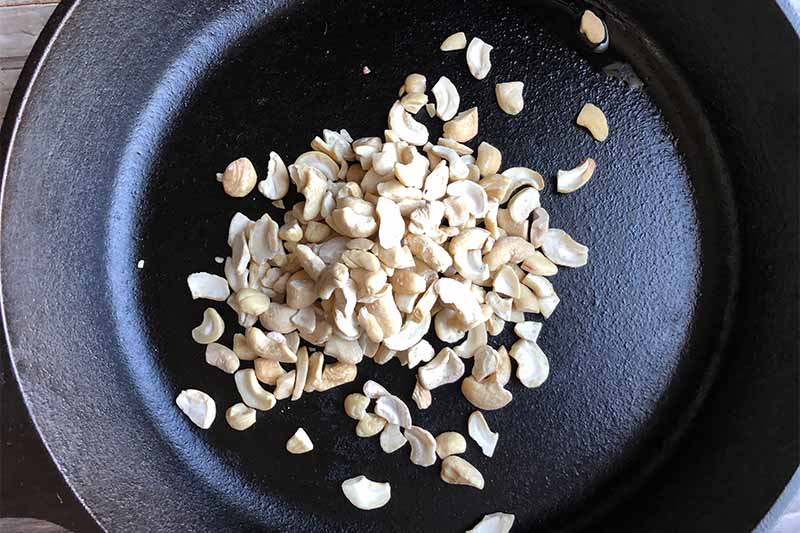
For this recipe, you want to start with raw, unroasted and unsalted cashews, and unsweetened coconut flakes.
Place the raw cashews in a large skillet over medium-low heat. Cook until lightly toasted, stirring occasionally. This will take about five minutes. Be sure to keep an eye on them, because you don’t want them to burn.
Remove the cashews from the skillet and set them aside. Return the skillet to the heat.
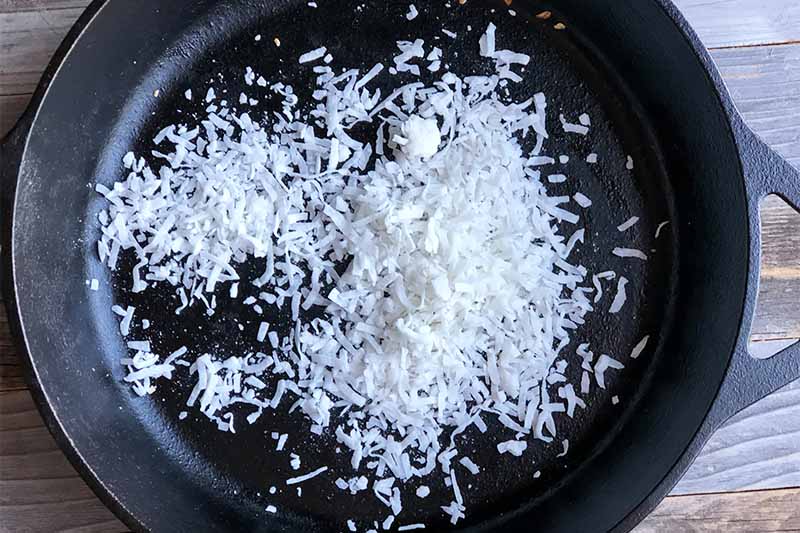
Next, add the coconut flakes to the skillet and toast them for 1-2 minutes, or until the edges are just beginning to brown lightly. Remove the coconut from the skillet and set it aside with the nuts.
Step 3 – Saute Onion
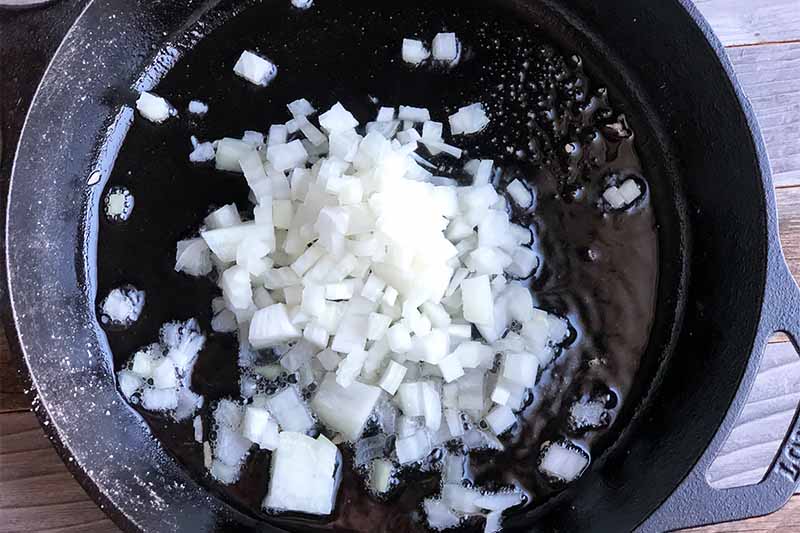
Place the coconut oil in the skillet and increase the heat to medium.
Once the oil has melted, swirl the pan to coat it. Add the onion and cook for 3 minutes, or until soft and translucent, stirring frequently to avoid burning. Turn the heat down a little if you need to – you don’t want the onion to brown.
Step 4 – Add Remaining Ingredients
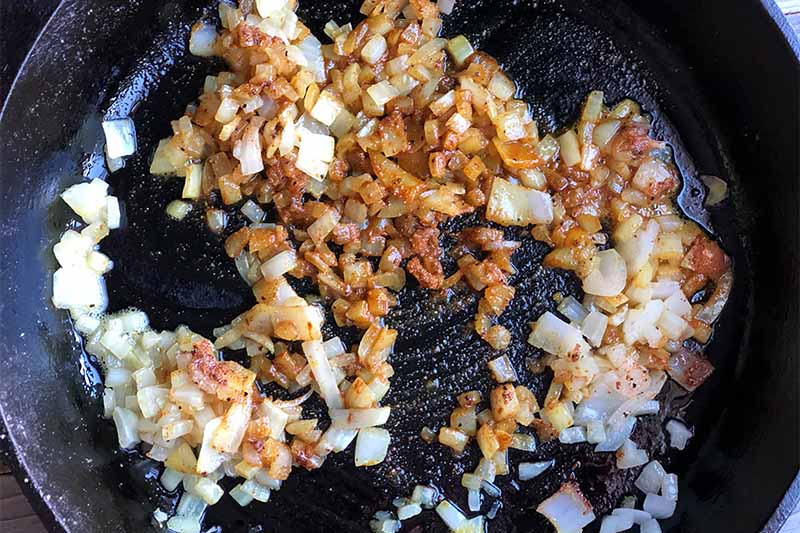
Now, it’s time to add all of the spices. Stir to combine, and continue to cook for 1 minute, or until fragrant.

Stir in the riced cauliflower, frozen peas, cashews, and coconut. Cook until the peas and cauliflower are heated through. If you want to add a pre-cooked protein to this dish, now’s your chance! Add it to the pan now, and stir occasionally until heated through.
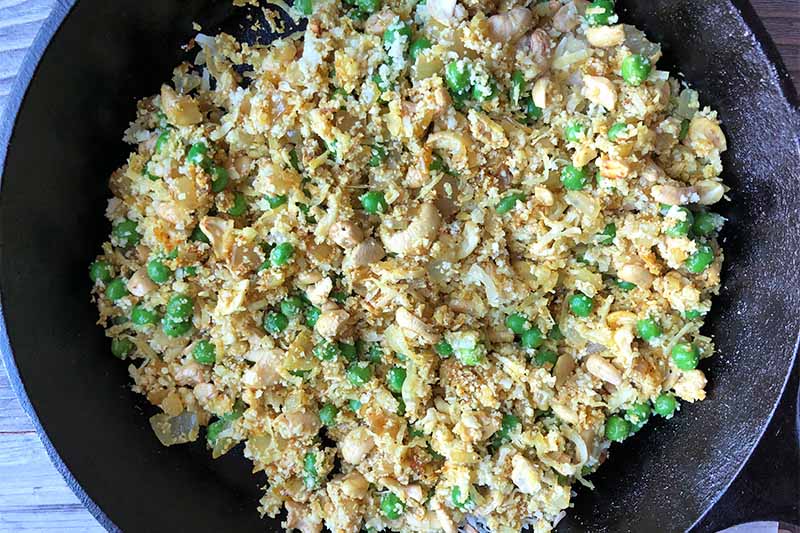
Remove the skillet from the heat and stir in the lime juice. Serve and enjoy.
Don’t Let That Cauliflower Go to Waste!
Besides being a low-carb substitute for rice, cauliflower is a nutrition powerhouse. With just 27 calories per 1-cup serving, this cruciferous vegetable also provides 77% of the daily value (DV) for vitamin C, 20% of the DV for vitamin K, and 10% of the DV for both folate and vitamin B6.
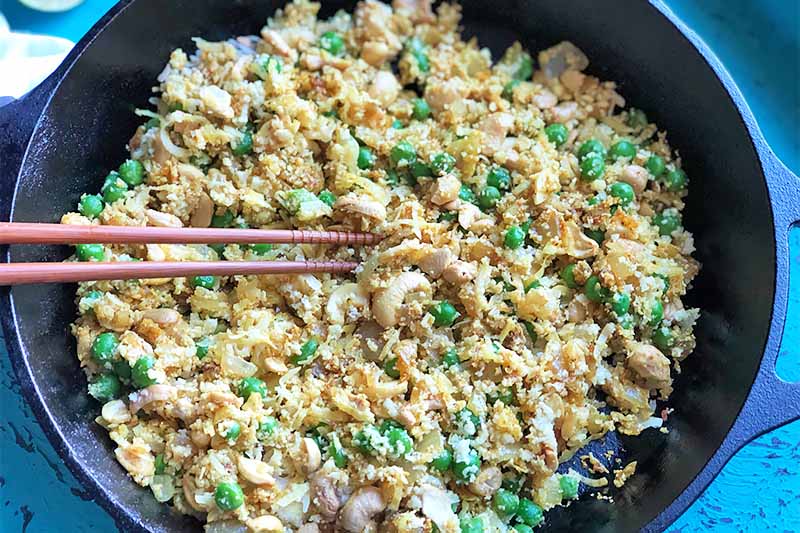
Plus, it’s a good source of fiber, which is good for heart and digestive health.
So, with all these benefits, it’d be a crime to let any leftover cauliflower to go to waste. Now that you know how to rice it yourself at home, just think of all of the delicious dishes that you can make!
Here are a few Foodal favorites that feature cauliflower to put it to good use:
- Gluten-Free Cauliflower Pizza Crust
- Easy Vegan Cauliflower Buffalo Wings
- Riced Cauliflower Stuffed Peppers
Love this Indian-spiced take on fried rice? Tell us how it turns out, as well as any additions or substitutions you use, in the comments below. And don’t forget to leave a 5-star rating to let others know how good this recipe is!
Photos by Kelli McGrane, © Ask the Experts, LLC. ALL RIGHTS RESERVED. See our TOS for more details. Originally published by Shanna Mallon on May 10, 2012. Last updated on June 22, 2020. With additional writing and editing by Allison Sidhu.
Nutritional information derived from a database of known generic and branded foods and ingredients and was not compiled by a registered dietitian or submitted for lab testing. It should be viewed as an approximation.
The written contents of this article have been reviewed and verified by a registered dietitian for informational purposes only. This article should not be construed as personalized or professional medical advice. Foodal and Ask the Experts, LLC assume no liability for the use or misuse of the material presented above. Always consult with a medical professional before changing your diet, or using supplements or manufactured or natural medications.
About Kelli McGrane, MS, RD
Kelli McGrane is a Denver-based registered dietitian with a lifelong love of food. She holds undergraduate and master’s degrees in nutrition science from Boston University. As a registered dietitian, she believes in the importance of food to nourish not only your body, but your soul as well. Nutrition is very personal, and you won’t find any food rules here, other than to simply enjoy what you eat.

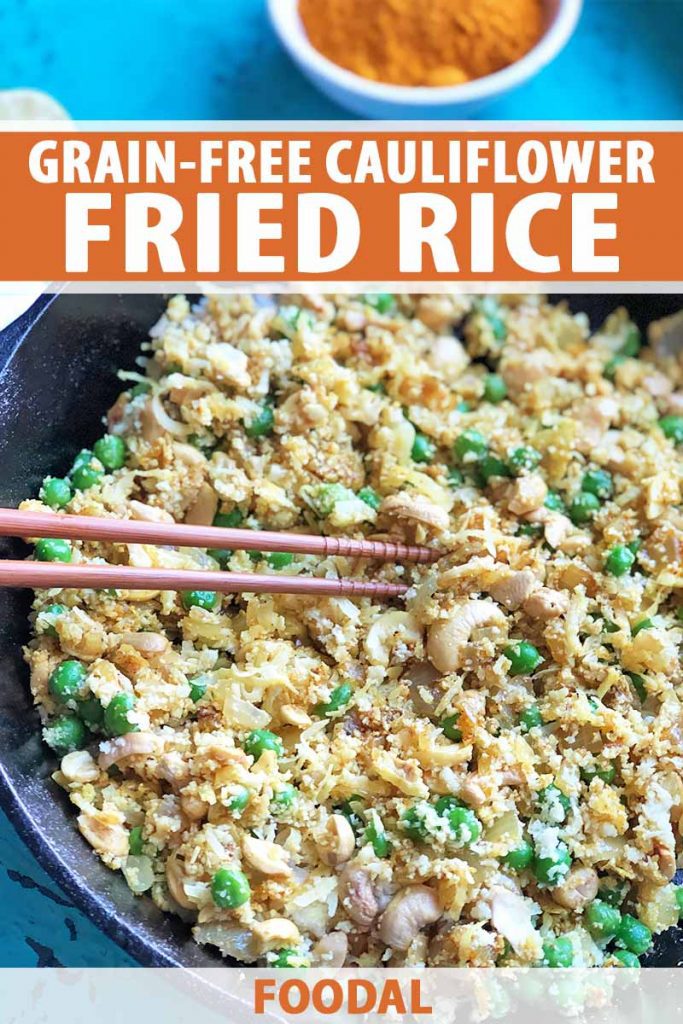
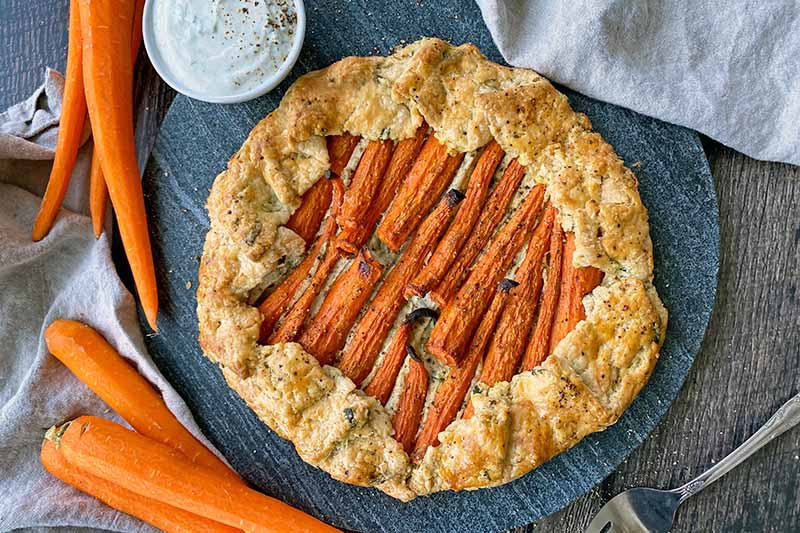
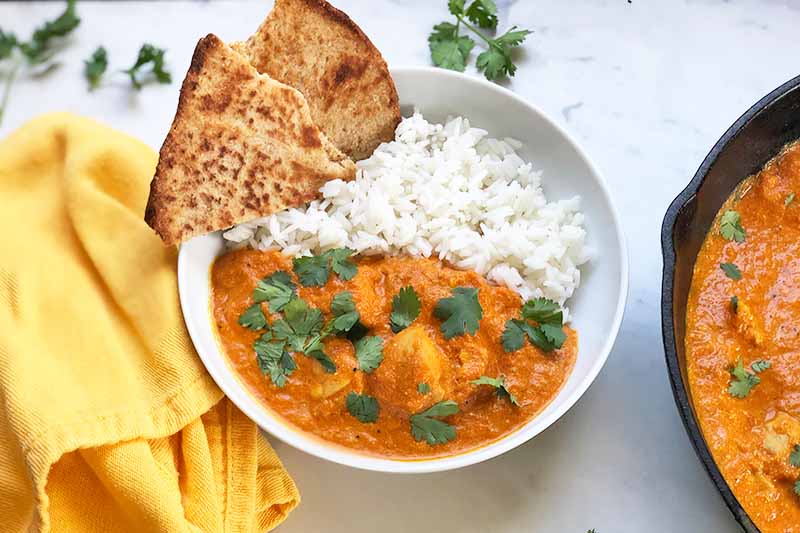
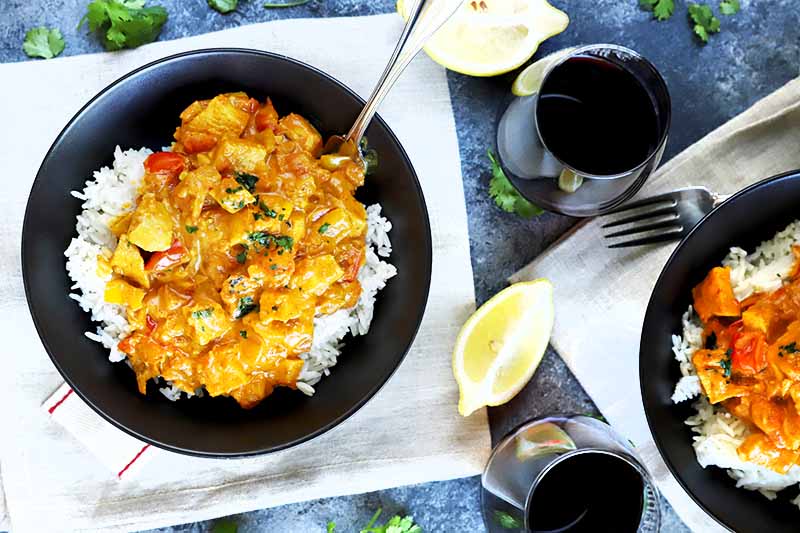
Thanks so much. The recipe looks so good and I have been into cauliflower a lot too recently. And a beautiful post as well. Thanks,.
Love your post and the fried rice looks absolutely delicious.
Love this post. Love seeing this recipe, as cauliflower has been one of my vegetable obsessions recently as well. 🙂